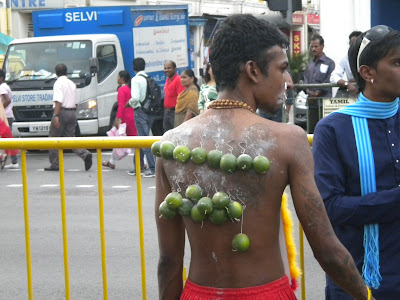Thaipusam is celebrated only in a few locations in the world, including Malaysia and Singapore, and parts of India and Sri Lanka. In Singapore the procession leads through the city from the Sri Srinivasa Perumal temple on Serangoon Road to the Sri Thendayuthapani temple on Tank Road, about 4 km. The festival is celebrated by Tamil Hindus only, and only in areas where Tamils are the majority ethnic group.
There has been some controversy here in Singapore, where local regulations impacting the festival are seen as religious discrimination. Under the rules, devotees are prohibited from playing recorded music or sounding gongs or drums, from painting their faces, bodies or wearing any form of disguise, and from shouting or unruly behaviour. Singing religious hymns relevant to the festival is permitted. Authorities counter that these rules apply to all religious groups and ceremonies in Singapore, and are in place to assure safety and orderly conduct for the public.
Devotees begin the ceremony by fasting approximately 48 days prior to the procession ceremony. On the day of the ceremony the devotees may show their devotion to Murugan by shaving their heads, or carrying some form of kavadi in the procession. The kavadi can be merely pails of milk, ornate canopies carried on the shoulders, or ornate wagons pulled by the kavadi bearers. However, many of the kavadi bearers show their devotion to Murugan by more dramatic means-- the kavadi are attached and supported by steel rods or strings connected to hooks inflicted into the flesh of the bearers. In other symbolic gestures, the bearers have pieced tongues or cheeks with arrows or vel (arrow or spear of Murugan) that prevent them from speaking. Greater pain brings more merit to the bearer in the eyes of Murugan.
It was a fascinating ceremony, with many in attendance. Elaine and I followed the route of the procession, from the Sri Srinivasa Perumal temple in Little India to the Sri Thendayuthapani temple and sanctum near Fort Canning. The procession and event reminded me of a sponsored running race, such as those held in the U.S.-- there were refreshment stops along the way for the procession participants and festival spectators. (We chose an alternative-- to stop at a restaurant along the route to have a Tiger beer and appetizer. With our own kavadi-- the extra LBs in our waistlines, I guess we needed the break!).
At the destination temple, those entering were required to remove their shoes (plastic bags provided). There were hundreds of identical plastic bags of shoes along the cordoned route to the temple. Elaine continued into the sanctum of the temple (where she got stuck inside in the crowd for over an hour). I did not care to be in the very claustrophobic crowd, so I waited outside, holding Elaine's shoes. I don't know how others located their shoes in the sea of bags, although perhaps you could trade up, if you could find your size.
 |
| Sri Srinivasa Perumal temple -- the Thaipusan procession starts at this temple. |
 |
| No talking!-- This young devotee has had his tongue and cheeks pierced by the arrow or vel skewers, which prevents any speech. It also makes it difficult even to drink water. |
 |
| In the eyes of Mugudan, no pain, no gain! |
 |
| Limes are attached to the back with small hooks. |



OK.. are you telling me all those 'wires' are actually stuck into that guy????
ReplyDeleteAnd thank you for sharing the cultural history as well! Love getting these insights into 'what up' over there!!!
Yes, the 'wires' are attached with hooks, much like those evident with the man with the limes on his back. Some have strings with what looks like pearls attached, rather than rods. Others had strings, which were attached to "chariots" or carts, that they pulled along with the strings. One other had strings on his back, which was pulled by an attendee-- looked like he was on some type of sadistic leash.
ReplyDeleteI'm not sure what the white powder is-- may be something to numb the skin. Surprisingly, no visible blood-- I'm not sure how this is accomplished. But definitely connected to the skin through some type of piercings.
I find the piercings with the vel the most bizarre.
The festival attendance apparently has been growing each year-- it's something to see. In October there is another festival where there are fire (hot coal) walkers-- we need to check this one out too.